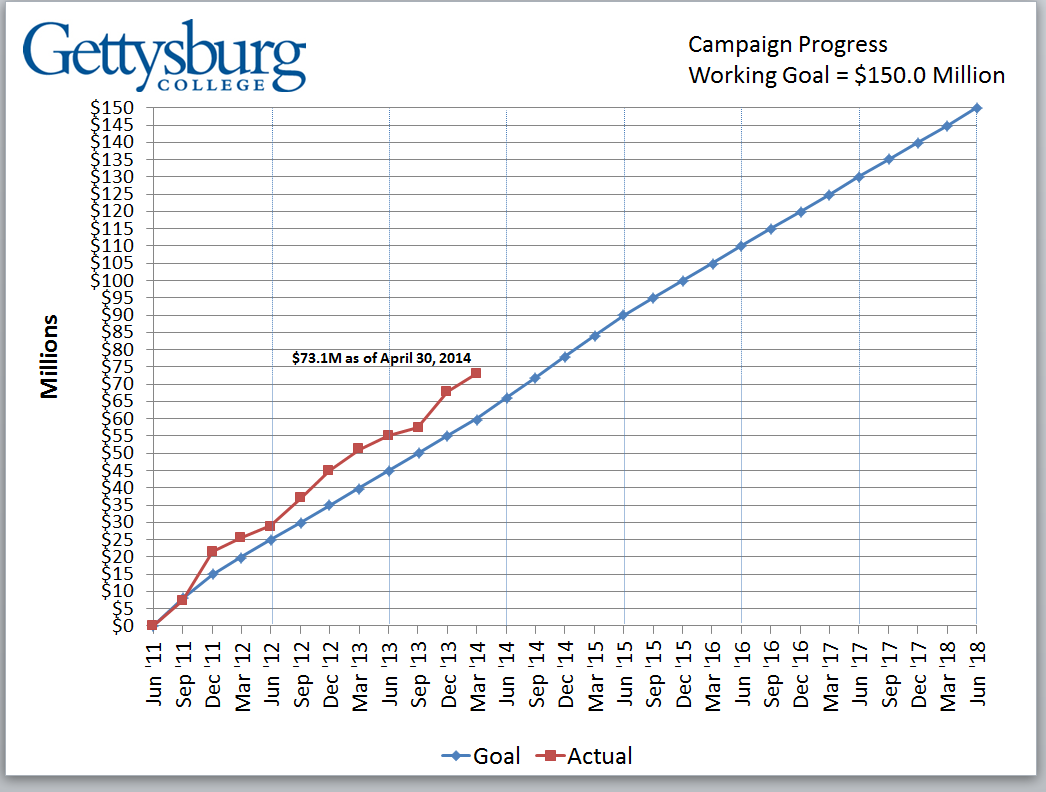
Related articles:
Spring Clean Your Major Gifts Portfolio
4 Lessons Learned from Campaign Volunteers at Gettysburg College
Today, Ashlyn Sowell, Gettysburg’s associate vice president and campaign director, with input from Gettysburg’s director of advancement services, walks you through the process of developing effective campaign reports — and discusses several sample reports.
We hope you will find this article useful and share it with your colleagues.
As we prepared for our campaign at Gettysburg College, we knew that we had to have accurate, easy to understand, and useful campaign reports. In addition to the staff needing to know where we stood on our progress to goals, our president and the trustees were interested as well. Here are a few tips based on what we learned that might help you to get yours right the first time!
1. Clean Up Your Data
Our last campaign ended in 2004, but believe it or not, we had some outstanding data issues to clean-up. You can imagine – pledges that had not been fulfilled or written off, pledges that had been extended, planned gifts that had not been recorded accurately, etc. We all wish we did not have these niggling issues, but we do.
We had also done some fundraising for a major building project that donors were still paying on, but we wanted to be certain not to count that in our current campaign. So we worked together with the advancement systems and major/planned giving staffs and got our data in order.
2. Decide What Counts
We had two major issues to tackle here. First, our gift acceptance policy had not been updated since 1994. It needed some attention, and we also decided to increase some of our naming levels for gifts. We had a major task force working for months from the development office in conjunction with the finance office. This process actually raised some good questions and allowed us to streamline our policies and clarify our language.
Second, we created a crediting policy for the campaign, outlining what gifts would count and in what time period. CASE (the Council for the Advancement and Support of Education) and PPP (the Partnership for Philanthropic Planning) both have great guidelines on these matters, but you have to decide how to implement and interpret them at your institution. We also wanted to clarify our “reach back” gifts. We only have a few and they are fine to count as long as they are defined prior to the campaign and are transparent on the reports.
3. Choose and Build Your Reports
We started by looking at other schools’ reports to see what might work best for us. I found that my colleagues and our campaign consultant were more than willing to share. Many of them just removed any identifying data and sent it on to us. We ended up with four key reports for Gettysburg:
- Campaign Progress Report to Goal
- Campaign Progress Report by Objective
- Campaign Progress Report by Source
- Campaign Pyramid Report
THE CAMPAIGN PROGRESS REPORT TO GOAL
This first report is a very simple line graph (see Figure 1 for an example) with a blue line showing quarter by quarter where we should be to make our final goal and a red line showing where we actually are. This is my vice president’s favorite report, and luckily the red line has been above the blue line so far! We have also used this to show various scenarios to the Campaign Planning Committee by changing the dollar goal and/or timeline as we were considering a working and then a public goal.

Figure 1: Sample Campaign Progress Report to Goal
CAMPAIGN PROGRESS REPORT BY OBJECTIVE
This report shows our five sub-goals within the campaign and where we are in cash and pledges as well as deferred gifts. Of key importance to us was that we were able to run these reports out of our database (we use Ellucian’s Advance). That required a lot of fine-tuning in terms of making sure that gifts were entered and coded correctly, especially to fit into the objective report. We also had to do some staff training across the board on our proposals so that planned gifts fell into the right buckets.
CAMPAIGN PROGRESS REPORT BY SOURCE
This was one of the simplest reports to prepare. It shows who is giving the money (i.e. alumni, parents, foundations, etc.). The decision point you do have to make is for an entity with many ties to the institution, what is the priority designation? We use alumni status as the top priority, and you can only count in one source.
CAMPAIGN PYRAMID REPORT
Finally, a Campaign Pyramid Report shows our projected pyramid compared to our actuals. We have the ability to look at this year by year, or as a whole of the campaign. This helps to see at what levels we may be ahead or lagging in our projections and make adjustments to our strategies as appropriate.
Test, Test, Test
All along the way we were testing these reports. The advancement systems team was testing them and the development staff was spot-checking to see that donors and gifts appeared in the right categories and for the right amounts. We’ve had to sort out things like not double-counting, soft credit for family foundations, and the very special circumstances around giving through donor-advised funds that don’t let you record pledges. You have to strive to be accurate, but creative at the same time. We also have had a strict policy to not put reports in front of our lead volunteers until we are sure they are correct. We can’t risk them losing confidence in us or our data.
AN INSIDE LOOK AT GETTYSBURG’S CAMPAIGN REPORTING PROCESS
Our director of advancement services, Anne Cherry, is a remarkably upbeat and positive person. Her background in data systems for health care gave her some great skills to be patient and persistent when it comes to building these reports. She shares the following about our process:
“Embarking on a new campaign is an excellent opportunity to look at not only your data, but your systems and procedures in general to see what features you can better take advantage of so that when you blend the “Art and Science” of reporting, you get accurate and usable results. Making sure everyone is speaking the same language is also key. If a common term like gift, pledge or commitment is interpreted differently by the report writer, it can have a big impact on the results. As the campaign moves to the public phase, our reports will continue to evolve and in the end, customer service and flexibility are crucial. We try and anticipate what information our colleagues will need, even if they don’t explicitly ask for it. The ability to drill down to transactional data or developing ways to visualize a donor’s “total commitment” to the campaign are examples.”
Developing the campaign reports for Gettysburg took more time than I anticipated, but getting it right the first time is … well, you know, priceless!
___________________________


